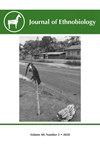蝙蝠的民族生物学:在快速变化的世界中探索人与蝙蝠的相互关系
IF 1.3
3区 社会学
Q1 ANTHROPOLOGY
引用次数: 15
摘要
摘要尽管蝙蝠主要在夜间活动,难以捉摸,但几千年来,蝙蝠一直吸引着人类。从玛雅神话中无处不在的蝙蝠,到中国清朝中后期被视为好运的象征,蝙蝠在世界各地的文化中既令人恐惧,又备受推崇。本书收录的研究文章说明了蝙蝠和人类长期以来互动的无数方式,突出了这些空气传播的哺乳动物在某些文化中是如何与死亡、巫术、吸血鬼、恶毒的灵魂和邪恶联系在一起的,而在其他地方——尤其是在亚太地区——它们在很大程度上与运气和好运联系在一起,并被用作精神图腾。这个收藏品还展示了多个文化群体,特别是在热带地区,如何以传统方式猎杀蝙蝠供人类食用和传统药物,并将它们的鸟粪用作肥料。在全球快速变化的时代,当蝙蝠往往与人畜共患疾病风险联系在一起时,这一趋势因COVID-19大流行而被放大,本期特刊是朝着更深入了解蝙蝠与人类相互关系迈出的重要一步。随着时间的推移,人类和蝙蝠的生活紧密地交织在一起,我们的收藏颂扬了蝙蝠的多样性如何支持我们星球的生物文化丰富性。本文章由计算机程序翻译,如有差异,请以英文原文为准。
Ethnobiology of Bats: Exploring Human-Bat Inter-Relationships in a Rapidly Changing World
Abstract. Although elusive due to their mostly nocturnal behavior, bats have fascinated humans for millennia. From their ubiquitous presence in Mayan mythology to being regarded as symbols of good fortune in the Middle-to-Late Qing Dynasty of China, bats have been both feared and celebrated across cultures from all over the world. The research articles included in this collection illustrate the myriad ways in which bats and humans have interacted over time, highlighting how these airborne mammals have been associated with death, witchcraft, vampires, malevolent spirits, and evil in some cultures, while, in other places—particularly across the Asia-Pacific region—they have been largely linked to luck and good fortune and used as spiritual totems. This collection also showcases how multiple cultural groups, particularly across the tropics, have traditionally hunted bats for human consumption and traditional medicine, and used their guano as a fertilizer. In times of rapid global change and when bats are often associated with zoonotic disease risks, a trend that has been magnified by the COVID-19 pandemic, this special issue constitutes one significant step towards a richer understanding of bat-human inter-relationships. The lives of humans and bats have been closely intertwined over time and our collection celebrates how bat diversity supports the biocultural richness of our planet.
求助全文
通过发布文献求助,成功后即可免费获取论文全文。
去求助
来源期刊

Journal of Ethnobiology
Social Sciences-Anthropology
CiteScore
4.80
自引率
3.40%
发文量
21
审稿时长
>12 weeks
期刊介绍:
JoE’s readership is as wide and diverse as ethnobiology itself, with readers spanning from both the natural and social sciences. Not surprisingly, a glance at the papers published in the Journal reveals the depth and breadth of topics, extending from studies in archaeology and the origins of agriculture, to folk classification systems, to food composition, plants, birds, mammals, fungi and everything in between.
Research areas published in JoE include but are not limited to neo- and paleo-ethnobiology, zooarchaeology, ethnobotany, ethnozoology, ethnopharmacology, ethnoecology, linguistic ethnobiology, human paleoecology, and many other related fields of study within anthropology and biology, such as taxonomy, conservation biology, ethnography, political ecology, and cognitive and cultural anthropology.
JoE does not limit itself to a single perspective, approach or discipline, but seeks to represent the full spectrum and wide diversity of the field of ethnobiology, including cognitive, symbolic, linguistic, ecological, and economic aspects of human interactions with our living world. Articles that significantly advance ethnobiological theory and/or methodology are particularly welcome, as well as studies bridging across disciplines and knowledge systems. JoE does not publish uncontextualized data such as species lists; appropriate submissions must elaborate on the ethnobiological context of findings.
 求助内容:
求助内容: 应助结果提醒方式:
应助结果提醒方式:


